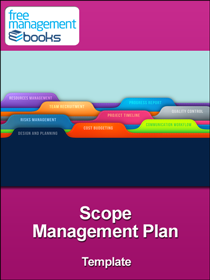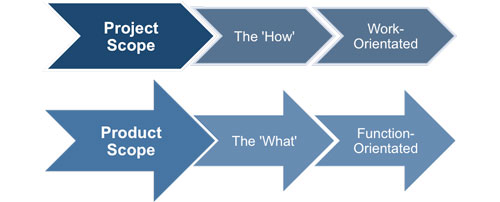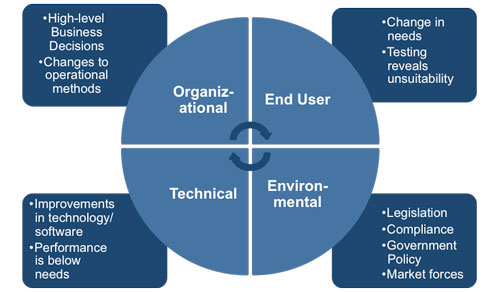
Scope Management Plan Template
A critical part of project management is the ability to manage the project scope from its inception through to sign-off. This template is designed to enable you to produce an effective scope management plan.
This plan ensures that everyone has a common and thorough understanding of the projects overall objective and how this need will be met. It defines the role and responsibility of every individual linked to the project and the communication that must occur between different parties to ensure it success.
Scope management is a vital skill for any project manager. It is relatively easy for a project objective to be set, but success depends on two things. First, ‘everyone’ (team members, stakeholders, third parties etc) must have a common understanding of how the project defines and delivers its end product or service. Secondly, all communications must be structured and appropriate.
The scope management plan ensures that all those involved in the project are appropriately communicated with and before the project starts have a comprehensive understanding of what the project means to them and the organization.
There are several stages to creating a scope management plan.
1) Collect requirements
2) Assign roles & responsibilities
3) Create WBS (work breakdown structure)
4) Validate and control scope

Project Scope Management
The scope plan enables the project manager to control and manage the definition of what is and is not included within the scope of the project. In addition to this plan there are several other key outputs of this process that are essential tools for any project manager, they are:
• Requirements document
• Project scope statement
• Work breakdown structure (WBS) & the WBS dictionary
• Acceptance deliverables
• Change requests.
Before any work can be done in terms of defining the exact scope of a project a comprehensive collection of ‘end user’ requirements must be made and their expectations understood. By reading the project charter and stakeholder register a project manager will gain a thorough appreciation of the project obligations and be able to write the requirements management plan. Then approval can be sought for the scope statement, usually referred to as the scope baseline.

Project Scope and Product Scope
It is essential at this stage that stakeholder’s expectations are set appropriately as part of this process and that they clearly understand the purpose of the project scope and do not confuse it with the ‘product’ scope. The difference between these two types of scopes is:
1) Project scope defines the ‘work needed’ to deliver a product, service or result.
2) Product scope describes the ‘features and functions’ of the product, service or result.

Once the scope has been defined the next task to be completed is to divide the project deliverables into practical chunks of work and define them in the resulting work breakdown structure (WBS) dictionary. The decomposition of project deliverables in this way is based on the assumptions, constraints and exclusions that have been agreed. Using the hierarchical structure created by WBS makes estimating costs and activities a more accurate process. It is essential that you have a thorough understanding and appreciation of your project requirements, including the acceptance.
Another key aspect of scope management that is essential to smooth project day-to-day operations and is defined in this plan is the way to validate and control the scope.
Monitoring Project Scope
Once the scope has been defined you need to gain formal acceptance of the project deliverables by the stakeholders and on their agreement your project scope is now approved. Any changes or alterations that arise after this sign off of the scope must adhere to your project’s change control process.
The scope management plan describes this approval and states whose signatures are required before a deliverable can be formally signed-off. By formally accepting deliverables throughout the duration of the project key personnel are kept up-to-date with progress and can see how the developing project is meeting the scope baseline.
Projects are evolutionary entities and controls must be put in place to ensure that the changes that develop overtime offer the same or improved benefits to the original requirements. Project managers clearly set out in this plan what constitutes a ‘change’ to the project scope and outline the formal process that any change must adhere to. There are several sources changes can come from as shown in the diagram below.

Scope Management Perspectives
Many organizations have a Change Control Board (CCB) that consists of members of the project team that review the change request forms and decide which are to be approved and those to be rejected. The CCB will follow the change request process outlined in the scope management plan. Once a project change request has been accepted and signed your scope baseline and any other appropriate project baselines must be update and a new version of the project management plan issued.
It is essential that you have strict controls over the change request process, other wise you could suffer from ‘scope creep’. This is where unacceptable or unqualified risks get introduced into your project often causing project failure in one form or anther e.g. missing key milestones or over spending against your budget.
Being able to efficiently manage the scope of a project is an essential skill for any project manager. To control a project scope you need to have three key things:
• Work performance data (current status, timely nature, cost component)
• Project plan
• Requirements documentation.
With the use of this template you will be guided through each stage of preparing an effective scope management plan that ensures success. This plan also ensures that all the necessary work and only that is clearly identified and scheduled.
